#CulturalExploration
Text
Katara the selfcare queen
Every canon instance or mention (that i can rmr) of Katara indulging in selfcare in the middle of a war because I find it quite amusing yet fascinating.
I may or may not have made a post like this before but I wanted to expand on it.
1. Skincare routine

In 1x14, The Fortuneteller, Katara reveals she has a special seaweed lotion that she carries with her for soft skin. (Avatar Extras also made a point of saying that it smells…?) She even offers to get Aunt Wu some, as if she has extra. So my question is, who is this plug that she gets her steady supply of seaweed lotion from? 😭
Real-life: Seaweed has been used in skincare for thousands of years, first recorded in ancient Chile. Nowadays, seaweed extract is pretty common in skincare products especially from emerging brands in Nunavik and Iqaluit, Canada.
My headcanon: This is probably a recipe Katara picked up from the older women of her tribe, so she just plucks some seaweed whenever the gaang stops by a body of water. And she definitely makes it in cute glass jars and shares it with her fellow healers in the Republic City Hospital ✨selfcare queen✨
2. Spa Day
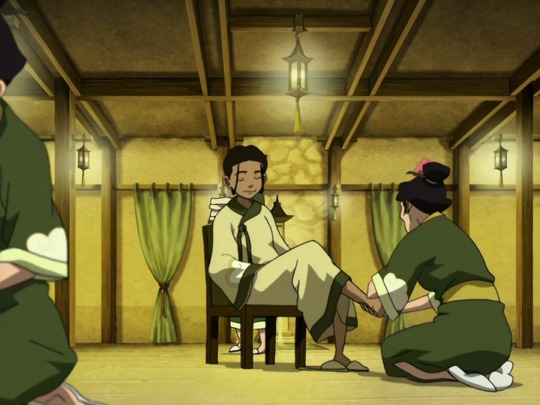
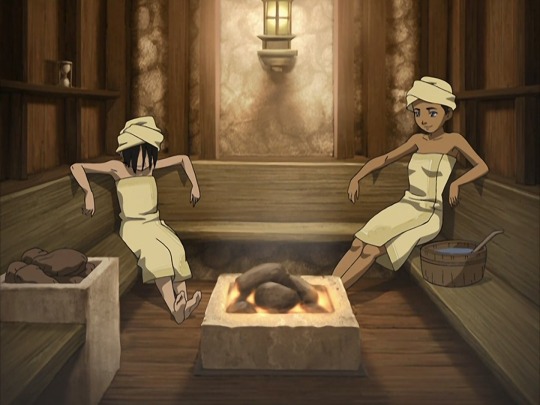

I just find this funny because when and how did she even find this spa? How long has she been going by herself? Look how comfortable she is like dhjfjcd she’s definitely a regular and they all know her.
Real-life: Saunas are pretty modern, starting up in Finland around 1112. (In canon, I think a firebender and a waterbender run a sauna in Republic City so hey.) Mudbaths on the other hand have been around for centuries and people have been doing it at any naturally occurring hot spring they can found. I don’t even have to tell you about massages so
My headcanon: Katara always knows where the spas and selfcare places are wherever they go. I definitely think she scooped up some stuff at the perfume abbey in season 1 (because she’s a kleptomaniac). I also headcanon she would have a spa setup in the back of Republic City Hospital because selfcare is healthcare too. Also, Aang gives her massages at home and he’s surprisingly good at it, but, Katara sucks at massages and Aang never lets her do it to him after that one time 💀
3. Yoga


In 3x11, Nightmares & Daydreams, Katara teaches Aang yoga to de-stress in a hot spring. My thing is, when did she learn about yoga and how often does she do it? We needed the Katara yoga mini shorts special. The kids would’ve loved it.
Real life: Yoga originating from ancient India is practised in a variety of forms in Hinduism, Jainism and Buddhism. The poses they do are the Upward Salute and the Wide Legged Forward Bend.
My headcanon: I imagine Katara must have read about this at the Air Nomad Section of the Spirit Library, given the cultural heritage. Knowing her she found a yoga scroll and swiped it (can you say klepto?). This is another selfcare thing she does with Aang because it’s his culture! They do it every Saturday until he starts complaining about his old bones 😅
4. Hair care


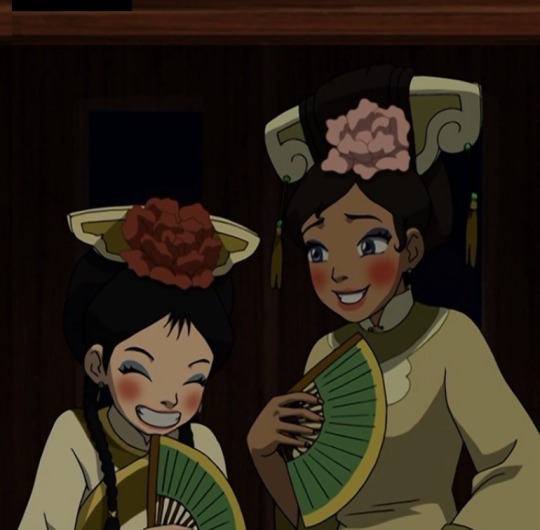

Katara also wears a special cap on her head when doing yoga which I assume is to protect her hair from the steam 🤔 I just found it very interesting since we hardly see her hair covered. Then I also realized Katara is the only character shown actually combing her hair and styling it like 4 times: from the bun-braid, to the formal earth kingdom look, to her fire nation look and finally the bun with her hair out.
Real life: I typed so many things and I finally found something similar called a chinoiserie satin skull cap? (sorry pic limit). It’s similar in design and even has a tassel like Katara’s. Focusing on her hairstyles, the signature “hair loopies” are actually based on a traditional Inuit style known as qilliqti and her earth kingdom look is based on a traditional Manchurian style called liangbatou.
My headcanon: Like Katara’s mysterious seaweed lotion recipe, she probably makes several haircare products for herself, and has a major hair routine. So, it would make sense she wears protective caps from time to time. I also think both Hama and Katara are tied to the myth of Senna, the Inuit sea goddess, through the comb Katara uses which I headcanon is the identical comb Hama had in her home (again klepto).
If there’s any more selfcare moments I left out, please feel free to share or reply with your own Katara ✨selfcare queen✨ headcanons!
#atla#katara#self care#self care queen#skincare#spa#yoga#haircare#culturalexploration#my headcanons#kataang#anti zutara
179 notes
·
View notes
Text
Elemental Work Crash Course
Hello friends! As a west witch I find myself in a lot of elemental spaces, but as an elemental pagan I feel like we get little to no representation without wicca being present so this post is for all my friends who may be looking into elemental work and want to know what to expect! This is an introductory post so if anyone is interested in further information let me know in the comments!

Earth
Common Lessons tend to include grounding, understanding your place within it all like your social circles, life itself, or even the ecosystem. People also tend to find out how to see beauty even when they feel there is none, home and hearth magic, generational magic, and harnessing your own power. Its important to recognize earth is extremely giving, often giving things without expecting anything in return. Remember to give back to the earth when you can in your practice, it isn't fair to take things without giving back. Eventually earth takes all things back from the living, so remember that earth is as powerful as she is kind
Darker Aspect/Element: Rot
How to honor and find these teachings:
Going out in nature
Taking care of plants
Herbal work
Community service
Exploring
Grounding and meditation outdoors
Connecting to earth itself
Evaluating what it means to be human
Common forms of divination
Osteomancy (Burning Bones)
Abacomancy (Dirt)
Dendromancy (Tree reading)
Falling petals or leaves
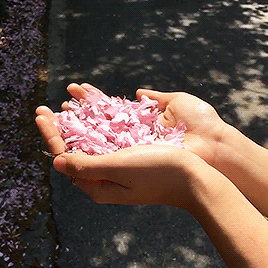
Air
Common lessons from air tend to be quick and ever present, air speaks rather quickly to people and messages change! Its best to keep a log of signs and messages you receive because it tends to be a pebble trail on your journey. Air teaches how to keep calm in tense situations, creating your own path on the journey of life, going with the wind and learning to not value materialistic lifestyles, plus learning how to be more gentle with yourself and others!
Darker Aspect: Tempest
How to honor and find these teachings:
Breath work
Spontaneity and leaving your comfort zone
Living to the fullest (however that might look for you!)
Dance or Hand motions
Meditations
Keeping sword or athame imagery as a talisman
Storm tracking
Common forms of divination:
Smoke Scrying
Wind Watching
Electromancy (By Lightning)
Austromancy (By Clouds)
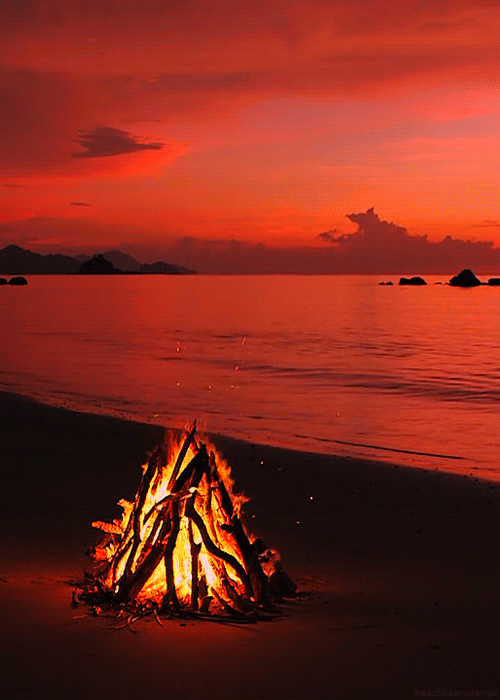
Fire
Common lessons in fire encourage you to listen closely and not rely so much on searching for messages. In most mythos fire speaks once per session, when its burnt out usually the message is over. Fire teaches us how to be confident in our work, ambition, and performance. Fire likes to throw a lot at you and teach you adaptability, and most importantly how to be the best you can be. You can learn a lot from just a little flame.
Darker Aspect: Magma
How to Honor these teachings:
Practicing Confidence
Glamour Magic
Using your backbone/saying no more
Making friends in odd places
Hosting bonfires/tending to a hearth fire
Using candle magic
Common forms of divination:
Fire Scrying
Candle/Wax reading
Flame Shape reading
Casting knives

Water
Common lessons range depending on what you are looking for! Water can teach you how to be calm and collected, but also encourages you to be fluid! so if you need to unleash the flood you know when its appropriate to do so. You also learn how to go with the flow, how to be persistent, and how to be a fierce enigma. Water is also very humbling at times, so you will learn a lot about yourself.
Darker Aspect: Abyss
How to honor these teachings:
Emotion based meditations
Shadow work
Being in tune with yourself
Swimming
Boating
Fishing
Beach cleanups
Exploring your waterways
Common types of divination:
Water scrying
Waves
Rainfall
Storm tracking
Mist/Dew
#elements#elementals#pagan witch#witchblr#witch#magical theory#grimoire#witchcraft#culturalexploration#divination#paganism#paganblr#pagan#earth#air#fire#water#spells
104 notes
·
View notes
Text
god I love to meet people with different cultural backgrounds so much and it feels so good to explore their cultures and customs which makes me wanting to learn a language they speak so bad especially as a someone who is in love with language learning
#culturalexploration#culture#different cultures#foreign languages#langblr#langblog#language learning#english language#language#languages#latin language#aspiring polyglot#polyglot#lingblr#linguistics
134 notes
·
View notes
Text
Karlach is one of the few characters I would make a straight character for.
Minthara(Mimfara, I so lovingly call her in an awful British accent) is a close second.
Idk what that says about me as a person.
#bg3#karlach#too gay for this#mlm#the only exception#bicuriosity#minthara#closet#gay#astarion#astarion simp#straight men#culturalexploration#mlw#tiefling#barbarian#infernal engine#bg3 avernus#beautiful#beautiful women#strength#power#strong
21 notes
·
View notes
Text
Crafting Authentic Slavic Characters: A Guide to Avoid Stereotypes and Embrace Diversity
A/N: I've been informed that people who have nothing on their blog can be mistaken for bots, so I decided to make one about something I'm really passionate about, as a Montenegrin woman. So sit back and enjoy :) (Keep in mind that I've never written a blog before, not even in my native language, so excuse any mistakes.)
Dear writers and storytellers,
As we dive into the art of character creation, it's essential to recognize the significance of crafting Slavic characters authentically and respectfully. Our stories have the power to challenge stereotypes and foster cultural understanding. This guide aims to provide a balanced perspective on what to do and what not to do when developing Slavic characters.
1. Do Research Thoroughly: Invest time in researching Slavic cultures, languages, history, and traditions. The more you know, the better you can authentically represent Slavic characters.
2. Don't Rely on Stereotypes: Avoid portraying Slavic characters solely through stereotypes like the "Russian villain" or "stoic Eastern European." Break away from these clichés.
3. Do Embrace Diversity: Recognize the diversity within the Slavic region. Slavic culture varies greatly from one country to another, so consider this when creating characters.
4. Don't Use Accents as a Crutch: Avoid heavy phonetic accents in dialogue, as they can come across as caricatures. Instead, convey their origin through subtle language choices.
5. Do Develop Complex Personalities: Slavic characters, like any others, should have multi-dimensional personalities, aspirations, and flaws. Make them relatable.
6. Don't Overdo "Tragic Backstories": While adversity can make a character compelling, avoid making every Slavic character's life a never-ending tragedy.
7. Do Consult Sensitively: If you're not from a Slavic background, consider seeking input from individuals who are. Be respectful and willing to learn.
8. Don't Fetishize Culture: Avoid reducing Slavic culture to exotic or mystical elements. Portray it respectfully, not as a novelty.
9. Do Challenge Prejudices: Use your writing to challenge stereotypes and prejudices, both within your story and in your readers' minds.
10. Don't Make All Slavic Characters the Same: Not every Slavic character should conform to a specific mold. Showcase their individuality.
11. Do Address Historical Context: If your story involves historical events or themes, handle them with sensitivity and accuracy.
12. Don't Neglect Positive Representations: While conflict can be a central theme, don't forget to include positive Slavic characters who contribute to the narrative in meaningful ways.
13. Do Avoid Cultural Appropriation: Use cultural elements respectfully and with proper context, avoiding appropriation or misrepresentation.
14. Don't Make Language Mistakes: If using Slavic languages in your writing, ensure they are used correctly to avoid unintended errors or offense.
15. Do Humanize Your Characters: At the core of it all, Slavic characters are human beings. Treat them with the same care, depth, and humanity you would any other character.
16. Don't Be Complacent: Writing authentic Slavic characters is an ongoing process. Continuously educate yourself and be open to feedback.
In conclusion, dear writers, crafting Slavic characters that break free from stereotypes and embrace diversity is not just a creative endeavor but a moral one. As storytellers, we have the power to shape perceptions and promote cultural understanding. By following these guidelines and committing to respectful and nuanced representation, we can contribute to a more inclusive and vibrant literary landscape.
Let's embark on this journey together, armed with knowledge and empathy, and create characters that truly reflect the rich tapestry of the Slavic experience.
You're also free to ask *me* any questions, if you have them and would like an answer from someone who's actually Slavic.
With sincerity and resolve,
Nyushka, a certified Slavic person :)
#writeblr#writerscommunity#ao3 writer#writer things#writblr#writerslife#representation matters#culture#slavic#slavic culture#slavic representation#inclusion#inclusivity#representation#representation in media#representation in literature#culturalexploration#culturalheritage#cultural differences#cultural diversity#diversity#diversity in media
24 notes
·
View notes
Text
Brezilyalı olduğum için Türkiye'nin gelenek ve göreneklerini bilmiyorum. Bana yardım edebilecek herkes minnettar olacaktır

17 notes
·
View notes
Text
Polish Versus Ukrainian Cuisine, Part 1
I have to confess, I have a little sin on my consciousness, namely, I visit Instagram sometimes. In most cases I do that just to catch up with my friends and family, but, you know, as most of young people of my age I just end up scrolling a tiny bit (usually, right until the moment I feel the urge to vomit, as I genuinely hate this place).
Recently, I came across a very cozy video where a Korean home cook mixes a Polish Pierogi Ruskie recipe with some Korean toppings. The thing that confused me the most, though, was the most liked comment under this video left by a Ukrainian woman who claimed that Pierogi Ruskie is a Ukrainian dish and is, in fact, called Varenyky. It's easy to assume that this person has never made a single dumpling, varenyk or pieróg in her entire life, as she kept on claiming that Pierogi Ruskie can have a lot of different fillings and that Polish Pierogi don't have such a big choice of fillings as Ukrainian Varenyky do, so, clearly, this person had zero idea what Pierogi Ruskie actually are, but that's not the point.
This comment made me wonder how different are the two cuisines of those Eastern European countries. Having lived long years in both countries, I thought it would be interesting to study this topic a little bit, namely from the perspective of the difference between the staple dishes in two cuisines. After all, we actually are what we eat, especially on the global scale. Everyone knows Italy for their brilliant pizza and pasta, and everyone knows Japan for sushi and tempura, and even though food is not the only aspect of those cultures that made them famous around the world, it definitely adds up to create a full picture of their collective cultural identity.
So, in this post I'd like to share some personal observations that I made throughout my life about Polish and Ukrainian cuisine having lived significant portions of life in both countries, being ethnically related to both and being wholeheartedly fascinated by food.
Disclaimer!!! I'm not a food scientist or chef, nor am I a professional historian. All the notes down here are mostly based on my personal observations and some basic research. I did consult a professional cook and a baker whom I know personally as they happen to be my family members. I do recommend treating everything I share here with a grain of salt (hehe, because we gonna talk 'bout cookin', hehe, so use salt) and bear in mind that different cooks have different approaches to their recipes and your personal experience with Ukrainian and Polish food might differ from mine. That being said, I encourage you to share these experiences whether you are Ukrainian, Polish or anyone else, really. I do not accept such arguments as "Ruskie because Kyiv Rus!", though, as it's not about arguing in the first place, it's about diving into the heritage of those two countries and talking about the food.
Pierogi vs. Вареники


Let's start with them culprits. I think those two dishes are the most confusing ones because of their similarity. Gosh, both of them are dumplings from Eastern Europe shaped like a growing moon, aren't they?
The dough for both dishes varies from region to region, from cook to cook. In my experience, both recipes need three basic ingredients:
- liquid
- salt
- flour
The rest depends, really. You can change the four, you can change the liquid, replacing water with milk or kefir, you can add an egg. I personally go with my mother's recipe which is boiling hot water, egg, AP flour and salt.
Two of the striking differences are their size and shape. It seems like Ukrainian dumplings are usually smaller, flatter and quite translucent in comparison to Polish ones, which are big, sometimes even huge (check Pierogi Po Bieszczadzku, they are bigger than my fists, I kid you not), they have a very full body and the dough itself is thicker (the reason is not so much ingredients in the dough as is the method of forming/cutting the circles out of it). They also have a lot of different really funny regional names which very often also refer to the size, shape, filling or method of preparation, for instance, Dzyndzałki (Warmian small dumplings served in soup), Bulwanki (Eastern Polish holiday pierogi with variety of savoury fillings), Sasznie (A type of dumplings from Eastern Borderlands that use potato in the dough) or Sójki (Masovian baked pierogi made with yeast).
The fillings of both Pierogi and Varenyky basically might create their own multiverse. In both Poland and Ukraine, I found so many different combinations of fillings that it would be a waste of time to write about each one of them. However, Pierogi most often have savoury fillings (from meat through cheese and potatoes though different types of groats and the list goes on and on..), while Varenyky have a bigger variety of sweet fillings, including the classic cherry filling. Also, Ukrainians seem to be not very much into the meat filling. In my childhood, I had never eaten meat dumplings in Ukraine, however, at the time, pelmeni were quite a popular alternative. Ah, classic Soviet influence - replace your own with something russian )yuck.
As for the toppings, depending on what kind of filling you are dealing with, there are many alternatives for both dishes, including chives, fried bacon, sour cream, melted butter, caramel sauce (haven't seen this one in Ukraine, but noticed it being popular in Poland with sweet cottage cheese Pierogi) and many others. Both dishes are absolutely marvelous even without any additions.
Now, if anyone says that Pierogi Ruskie are called that way because they are Ukrainian, they are not entirely wrong. This type of pierogi was invented in Eastern Galicia (a geographical region in Western Ukraine which was also used to refer to the Eastern part of Poland; The name derives from its Polish name of territory - "Ruś Czerwona" ("Ruthenia Rubra" in Latin)), however there's a high chance it happened when it was the part of Austrian Empire, when majority of population in this region, especially in big cities including Lviv, were Polish. Either way, this dish is much more popular in modern Poland and has lots of different regional variations that you can meet across the whole country (see the Bryndzylki designed by Polish Highlanders), while it's basically non-existent in Ukraine and in the country they are often called "польські пироги" (literally "Polish Pierogi". Pierogi Ruskie are prepared with cheese, onion and potato filling, while in Ukraine you are more likely to come across some Varenyky with potato, onion and bacon filling.
Thank you very much for your attention, share your dumpling preferences and experiences in the comments or in the reblogs, share your recipes, go crazy, and let's discuss the food!!
My pierogi variation with cottage cheese and strawberry jam filling (not the most attractively shaped one, but very tasty - my significant other approved them):
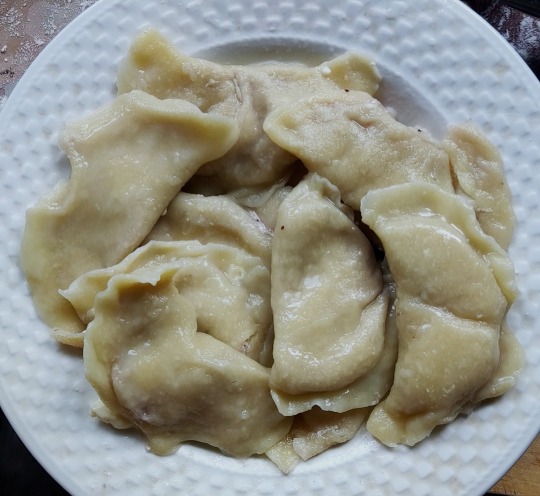
#poland#ukraine#pierogi#varenyky#polish cuisine#ukrainian cuisine#polish culture#ukrainian culture#dumplings#cultural differences#culturalheritage#culturalexploration#polska#polska tradycja#polish tumblr
8 notes
·
View notes
Text
It's only logical that pre-fall beliefs, customs and ideas still survive in 5016U, but warped beyond recognition.
Concept: In underground structures, tunnel networks and mines, it is traditional to place near the vents small statues of a mustachioed gnome laying down: these are effigies of the Sadon Huzin, benevolent underground spirits that bring good luck to those who leave them offers of treats and keep away kobolds.
For the latter reason, Karrakin soldiers fighting the Ungratefuls sometime wear similar effigies on their person. So far they don't seem to have a statistically significant ability to hinder Kobold frames; probably because those are actual mecha and not mischievous gremlins
11 notes
·
View notes
Text
It's Saturday which means...NEW EPISODE: Episode 11: It’s one of the most famous photos ever: the girl on the National Geographic cover with the bright green eyes. But not many know how angry she was in the photo or why she was so angry. After all, the photographer broke some cultural norms to get this important shot.
But this expose is more about the search for The Afghan Girl and how it took 18 years to find her. Sophisticated iris scans, weeding out false claims and the people claiming to be her, visiting various countries…it was an exhaustive search. But they did it. Here’s how they found her and what became of the famous Afghan Girl from that National Geographic cover.
This is the eleventh episode in a series of episodes that’ll drop every Saturday throughout 2024.
youtube
Share it with others if you enjoy it. Head over to my YouTube channel to watch (link in bio and description). Also linked in my stories.
#TheAfghanGirl #SteveMcCurry #CulturalPhotography #IrisPatternIdentification #PhotographyEthics #IdentityDiscovery #DocumentaryPhotography #PhotographySearch #CulturalExploration #Photojournalism #MustWatch #mccurry #photography #exhibition #mostra #art #nature #portrait #exhibitions #mountain #contemporaryart #museumlife #museomuse #musetrento #sciencemuseum #photo #science #naturallycurious #fotografia #arte #photographer #nationalgeographic #tcmacdesigns #travelphotography #afghangirl #india #streetphotography #museum #bari #stevemccurryofficial #asmr #athousandwords
#TheAfghanGirl#SteveMcCurry#CulturalPhotography#IrisPatternIdentification#PhotographyEthics#IdentityDiscovery#DocumentaryPhotography#PhotographySearch#CulturalExploration#Photojournalism#MustWatch#mccurry#photography#exhibition#mostra#art#nature#portrait#exhibitions#mountain#contemporaryart#museumlife#museomuse#musetrento#sciencemuseum#photo#science#naturallycurious#fotografia#arte
2 notes
·
View notes
Text
Unlocking Success: Navigating Diverse Business Services in the UAE
At Transcend Accounting, our dedication lies in empowering businesses with a comprehensive suite of services tailored to meet the Diverse Businesses needs of investors seeking success in global markets, including the dynamic landscape of the UAE. Our array of offerings covers every aspect of business establishment and growth, ensuring a seamless journey for our esteemed clients.
We Guide to Company Formation in the UAE: Embark on a journey through the intricacies of setting up a business in the UAE with our expert insights into legal requirements, documentation processes, and key considerations for entrepreneurs.
Visa Procedures Demystified: Navigate the various visa procedures required for business setup in the UAE with ease, as we provide invaluable tips and advice on streamlining the application process for a smooth entry into the UAE market.
Mastering the Art of Opening a Bank Account in the UAE: Dive into the nuances of opening a bank account in the UAE with Transcend Accounting, where we highlight different options available, key documentation requirements, and tips for selecting the right banking partner for your business.
Streamlining HR and Payroll: Our Best Practices for Businesses in the UAE: Our article offers actionable tips and best practices for managing HR and payroll processes in the UAE, ensuring compliance with local regulations and fostering employee satisfaction and productivity.
Navigating the Maze of VAT and Accounting Services in the UAE: Shed light on VAT compliance and accounting services in the UAE with Transcend Accounting's expert guidance, providing practical advice on regulatory changes, tax strategies, and financial transparency.
The Future of Business Services in the UAE: Trends to Watch by Transcend Accounting: Explore emerging trends in business services in the UAE with Transcend Accounting, offering insights into digital transformation and sustainability initiatives that enable businesses to adapt and thrive.
Success Stories: How Businesses Are Thriving with Transcend Accounting's Diverse Services in the UAE: Discover inspiring success stories of businesses leveraging Transcend Accounting's diverse services to achieve growth and success, providing valuable lessons and inspiration for your entrepreneurial journey.
Unlocking Opportunities: Exploring Niche Business Services in the UAE: Delve into niche business services available in the UAE with Transcend Accounting, highlighting opportunities for entrepreneurs to drive innovation and carve out a unique market position.
The Power of Partnership: Collaborating for Success in the UAE Business Ecosystem: Explore the importance of collaboration and partnerships in the UAE business ecosystem with our Accounting, showcasing successful collaborations and offering tips for mutual growth and success.
Beyond Business: Exploring the Cultural and Social Landscape of the UAE with: Join Transcend Accounting on a journey beyond business, exploring the rich cultural heritage and vibrant social scene of the UAE, fostering stronger business relationships and success through understanding local customs and traditions.
#TranscendAccounting#UAEBusiness#BusinessSetup#CompanyFormation#VisaProcedures#BankingUAE#HRManagement#PayrollServices#VATCompliance#AccountingSolutions#BusinessTrends#SuccessStories#NicheServices#PartnershipSuccess#CulturalExploration#EntrepreneurialJourney#BusinessGrowth#MarketInsights#CollaborativeEcosystem#CulturalUnderstanding
3 notes
·
View notes
Text
#youtube#vietnam#travel#travel photography#adventure#wanderlust#backpacking#nature#solo travel#travel blog#mekong#beachlife#culturalexploration#picsoftheday#travel enthusiast
3 notes
·
View notes
Text




i wish i could say that the river of my arms have found the ocean
#uiscefhuaraithe#vltava#czechia#cesky krumlov#beautiful world#clouds#i love water#boats#dark academia#aesthetically beautiful#historic#culturalexploration#medieval town#water sports#frui vita#terrace#picturesque#kafkaesquesoif
5 notes
·
View notes
Text
How to set personal intentions

Hello friends! I get asked time and time again "what does this herb do?" or "What can I use this crystal for?" Im here to share that there is an easier way than collecting books, dozens of websites, and trying to memorize what everything is and why!
Where do correspondences come from?
Correspondences come from cultural adaptations of a specific tools usefulness! Another aspect is most of these stem from their medicinal uses as well. For example: The idea that calendula is for spiritual healing stems from the idea that many cultures use it for physical healing and it was used as a common cure-all
With all that said, no 2 cultures will have the same intentions for the same tool. A crystal of protection in one culture may be a crystals of travel in another. This can get confusing and leads us to a modern day issue of watering down a tools usefulness and intentions. I see so many books that just say "Basil - Money, Luck, Banishing." But dont list why something is that way, where did it come from.
I reposted a previous post about the importance of asking why something is, and I think it still holds up to this day. It not only gets your brain flowing, but it helps deepen your craft.
How do I find correspondences then?
First, if you want to take a more general and historic root, look into the history of a tool! If its a herb look at the general medicinal properties and why it can do what it does (Example: Basil is antimicrobial, and therefore healing, in a lot of cultures because of Eugenol, it is able to defend against protozoa and fungus). When it comes to crystals look into where its native too, where it grows, then do a cultural deep dive to explore the original connotations of a crystal. Now: You don't have to follow only this, this is just simply establishing a why.
After you have done all this, or even if you are still researching when you get a tool simply ask it what its for. You may find that your collection of mint is actually for safe travels, and your obsidian cant protect you from entities! This may contradict online sources but that's ok!!! your tools are unique to your space, revel in that! You have an arsenal at your disposal, enjoy that!
How do I ask?
First, grab the tool in between the palm of your hand, sit with it, and then ask "What can you assist me with" or if your about to start a spell "Are you the right tool for this job?" then let the tool speak to you via intuition. You will feel a sharp yes, no, or start to get a sense of what it does. If you are just starting to work on your intuition that's ok too, not only is this exercise great for strengthen that, it can be versatile. Adapt your questions into yes or no answers because our bodies have an easier time starting with that when producing energy.
With all that said I hope you all enjoyed! Keep asking questions and stay curious!
#grimoire#witchblr#pagan witch#magical theory#witchcraft#witch#spells#culturalexploration#baby witch#intentions#magick#pagan
75 notes
·
View notes
Text

All Rights Reserved
#são paulo#sao paulo#brasil#brazil#cityscape#japanese#japanese art#photographers#urban#street#urban life#street photography#urban fantasy#photography#skies#culturalheritage#cultural diversity#culturalexploration#diversity#heritage#culture#culturaltours#photograph#my photos#photooftheday#picture#canonphotography#phtography#photoshop#photoshoot
2 notes
·
View notes
Text

#culturalexploration#templevisit#travelphotography#adventureseekers#worldexplorers#culturalheritage#traditionalarchitecture#sightseeing#travelbuddies#scenicviews#muscle#jock#bodybuilder#shredded#pecs#handsome
3 notes
·
View notes
Text
In this blog, we will delve into a wide range of social issues, including but not limited to racial inequality, gender disparities, discrimination, human rights, and cultural diversity. Our team of dedicated researchers, will offer unique perspectives and personal stories to provide a holistic understanding of these complex topics.
We understand that cultural differences play a significant role in shaping our societies, and we aim to explore these differences with respect and appreciation. Through our blog posts, we will shed light on various cultural practices, traditions, and customs, as well as the challenges and opportunities that arise from embracing diversity.

Our blog will serve as a platform for education, awareness, and respectful dialogue. We will provide well-researched information, statistics, and real-life examples to help our readers gain a deeper understanding of these social issues and cultural differences.
We also invite our readers to engage with us and share their perspectives, experiences, and ideas. We believe that by coming together and learning from one another, we can break down barriers, dismantle stereotypes, and promote unity.
As we share insights and information, we hope to inspire action and empower our readers to become advocates for positive change in their own communities. We will provide resources, suggestions for further reading, and ways to get involved, encouraging our audience to actively contribute to building a more inclusive and equitable world.
Together, let's make a difference.
2 notes
·
View notes